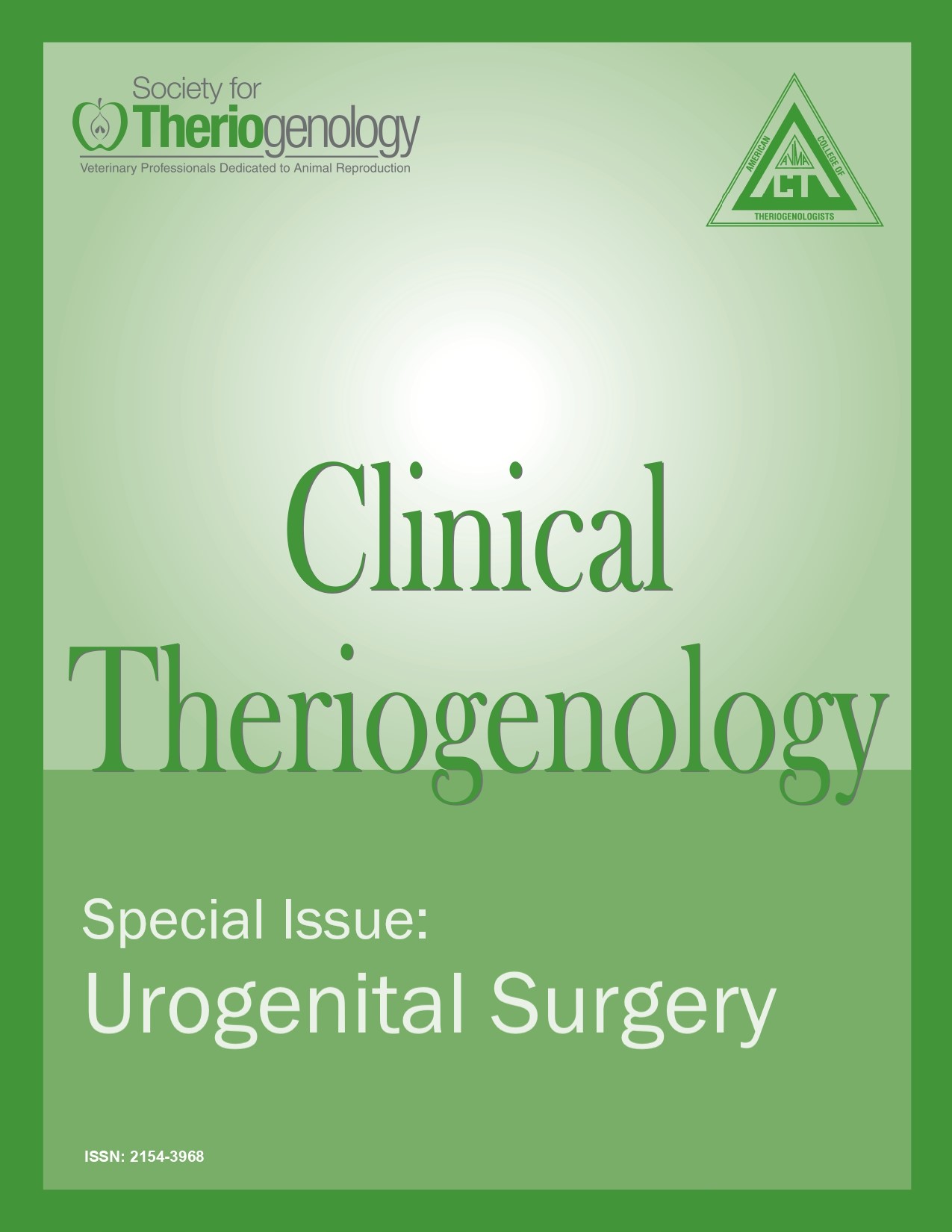Paraphimosis of 7 years’ duration in a Percheron stallion
Abstract
A 15-year-old Percheron stallion was presented to Auburn University Veterinary Teaching Hospital for evaluation of paraphimosis of 7 years’ duration. Available history indicated that the paraphimosis was subsequent to a kick injury that occurred 7 years prior. Vital parameters were within normal limits. The penis and prepuce were markedly fibrotic and swollen, extending to the level of the distal tarsus, and evidence of chronic penile exteriorization was present. Due to apparent lack of penile sensation and the chronicity of the lesion, phallectomy and castration were recommended. Distal phallectomy via the Williams’ technique was performed under general anesthesia, concurrently with closed castration. No excessive intraoperative hemorrhage was noted. Within 30 min postoperatively, the patient experienced mild hemorrhage from the stoma. Around 12 h post-surgery, the gelding exhibited dull mentation, pale mucous membranes, tachycardia, and tachypnea. The gelding was administered infusions of aminocaproic acid, 0.05% formalin, and a whole blood transfusion. By the following afternoon, packed cell volume had increased from 18 to 22% and total solids increased from 5.0 to 6.8 g/dL; vital parameters were within normal limits. The gelding was discharged 5 days postoperatively with normal vital parameters. Medications included phenylbutazone, trimethoprim sulfamethoxazole, and Red Cell®. Follow up telephone consultation with the owner several months postoperatively indicated the gelding had made a full recovery. This case describes resolution of a severely protracted paraphimosis and successful management of common, albeit concerning, postoperative complications.
Downloads
References
2. Moreno CR, Delph KM, Beard WL: Intravenous formalin for treatment of haemorrhage in horses. Equine Vet Educ 2021;33:460–465. doi: 10.1111/eve.13451
3. McDonnell SM: Managing the paralyzed penis, priapism or paraphimosis in the horse. Equine Vet Educ 2005;17:310–311. doi: 10.1111/j.2042-3292.2005.tb00398.x
4. Schumacher J, Varner DD: Abnormalities of the penis and prepuce. In: McKinnon AO, Squires EL, Vaala WE, et al: editors. Equine Reproduction. 2nd edition, Ames; Wiley-Blackwell: 2011. p. 1130–1144.
5. Simmons HA, Cox JE, Edwards GB, Neal PA, Urquhart KA: Paraphimosis in seven debilitated horses. Vet Rec 1985;116:126–127. doi: 10.1136/vr.116.5.126
6. Koch C, O’Brien T, Livesey MA: How to construct and apply a penile repulsion device (Probang) to manage paraphimosis. Proceedings of American Association of Equine Practitioners, Las Vegas, 2009 December; p. 338–341.
7. Brouwer ED, Ribera T, Climent F, et al.: Alternative method to facilitate resolution of paraphimosis after penile trauma in the horse. Equine Vet Educ 2017;29:655–658. doi: 10.1111/eve.12556
8. Walker DF: Surgery of the penis. In: Walker DF, Vaughan JT, editors. Bovine and Equine Urogenital Surgery, Philadelphia, PA; Lea & Febiger: 1980. p. 10.
9. Love CC, McDonnell SM, Kenney RM: Manually assisted ejaculation in a stallion with erectile dysfunction subsequent to paraphimosis. J Am Vet Med Assoc 1992;200:1357–1359.
10. Feary DJ, Moffett PD, Bruemmer JE, et al.: Chemical ejaculation and cryopreservation of semen from a breeding stallion with paraphimosis secondary to priapism and haemorrhagic colitis. Equine Vet Educ 2005;17:299–304. doi: 10.1111/j.2042-3292.2005.tb00396.x
11. Schumacher J, Varner DD: Surgery of the penis and prepuce. In: McKinnon AO, Squires EL, Vaala WE, et al: editors. Equine Reproduction. 2nd edition, Ames; Wiley-Blackwell: 2011. p. 1130–1144.
12. Schumacher, J: Penis and prepuce. In: Auer JA, Stick JA: editors. Equine Surgery. 4th edition, St. Louis; Elsevier/Saunders: 2012. p. 840–866.
13. Arnold CE, Brinsko SP, Love CC, et al.: Use of a modified Vinsot technique for partial phallectomy in 11 standing horses. J Am Vet Med Assoc 2010;237:82–86. doi: 10.2460/javma.237.1.82
14. Kilcoyne I, Watson JL, Kass PH, et al: Incidence, management, and outcome of complications of castration in equids: 324 cases (1998–2008). J Am Vet Med Assoc 2013;242:820–825. doi: 10.2460/javma.242.6.820
15. Gelser DR, Goble DO, Held JP: Normal hematology and serology of the Clydesdale draft horse. Equine Prac 1984;6:7–11.

This work is licensed under a Creative Commons Attribution-NonCommercial 4.0 International License.
Authors retain copyright of their work, with first publication rights granted to Clinical Theriogenology. Read more about copyright and licensing here.





